Icedrive vs Tresorit: Which Cloud Storage Option Wins in 2025?
If you’re looking at the cloud storage market for end-to-end encryption, Icedrive and Tresorit are excellent options. Icedrive has a dedicated encryption folder, while Tresorit applies private encryption to an entire account. We explore this and other elements of each service in our Icedrive vs Tresorit comparison piece.
Key Takeaways: Tresorit vs Icedrive
- The main difference between Icedrive and Tresorit is how each implements end-to-end encryption. Icedrive limits this to a folder, while Tresorit has private encryption for the entire account.
- Icedrive is the more affordable option, giving potential subscribers three recurring plan choices and three lifetime options.
- Tresorit has business plans that support team productivity and collaboration, with optional paid add-ons for eSign and Outlook encryption.
Icedrive and Tresorit are two cloud storage providers that offer excellent privacy and encryption to account holders. Both have great free accounts and rank among the best cloud storage services. However, Icedrive focuses solely on individual users, while Tresorit offers business plans to support teams. Let’s look at the similarities and differences as we compare Icedrive vs Tresorit.
In the competitive cloud storage industry, Icedrive and Tresorit both find ways to stand out. As a cloud storage platform, Tresorit has plans that will appeal to both individuals and businesses. Icedrive, on the other hand, offers a great user experience and phenomenal value on its paid plans.
-
07/08/2021
Updated article to account for Icedrive’s addition of two-factor-authentication.
-
07/16/2023 Facts checked
This article was rewritten to include updated features and pricing plans.
-
04/11/2024
Updated to reflect changes in Icedrive’s pricing plans and storage offers.
- 1
- :
- :
- :
- :
- 2
- :
- :
- :
- :
How Did We Rate Tresorit vs Icedrive?
We’ve reviewed over 100 cloud storage services. In our Icedrive review and Tresorit review, we spent time testing each cloud service in a variety of ways.
For this comparison, we focused on each service’s cloud features and critical components, such as security and privacy, and applied real-world scenarios to flesh out each service’s strengths and potential areas for improvement. With this information, we’re well positioned to accurately compare Icedrive and Tresorit.
Icedrive vs Tresorit: Similarities & Differences
Although Icedrive and Tresorit take different approaches to folder and file management, they share many similarities in terms of file sharing. Additionally, each has a downloadable virtual desktop drive, adding excellent functionality for account holders. Encryption is a big part of each service, although Icedrive and Tresorit handle this key feature differently.
| Features | ||
|---|---|---|
| 100GB – 3TB$2.99 / month(All Plans) 14-days money-back guarantee | 1TB – 4TB$11.99 / month(All Plans) | |
| Review | Review | |
| Sync Folder | ||
| Block-Level Sync | ||
| Selective Sync | ||
| Bandwidth management | ||
| Sync Any Folder | ||
| File Link Sharing | ||
| Link Passwords | ||
| Link Expiry Dates | ||
| Folder Sharing | ||
| Folder Permissions | ||
| Link Download Limits | ||
| Upload Links | ||
| File Previews | ||
| Edit Files | ||
| In-App Collaboration | ||
| Office Online | ||
| Google Docs | ||
| Notes App | ||
| Media Playback | ||
| Mobile Apps | ||
| Deleted File Retention | ||
| Versioning | ||
| WebDAV | ||
| At-Rest Encryption | 256-bit encryption | |
| In-Transit Encryption | TLS | |
| Encryption Protocol | Two-Fish/TLS | |
| Client-Side Encryption | ||
| Two-Factor Authentication | ||
| Server Location | EU | |
| 24/7 Support | ||
| Live Chat Support | ||
| Telephone Support | ||
| Email Support | ||
| User Forum | ||
| Knowledgebase | ||
| Free Plan |
Similarities
Icedrive and Tresorit are two of the best cloud storage provider options and are neck-and-neck in a number of areas, like security, privacy and speed. This means it’s hard to make a “wrong” choice if those features are important. Let’s explore.
File Sharing
File sharing is one of the base features that make up cloud storage. Both Icedrive and Tresorit have similar file sharing features. Icedrive lets you invite other Icedrive members as collaborators to folders using an email address. To share with those outside of Icedrive, you’ll have to create a link.
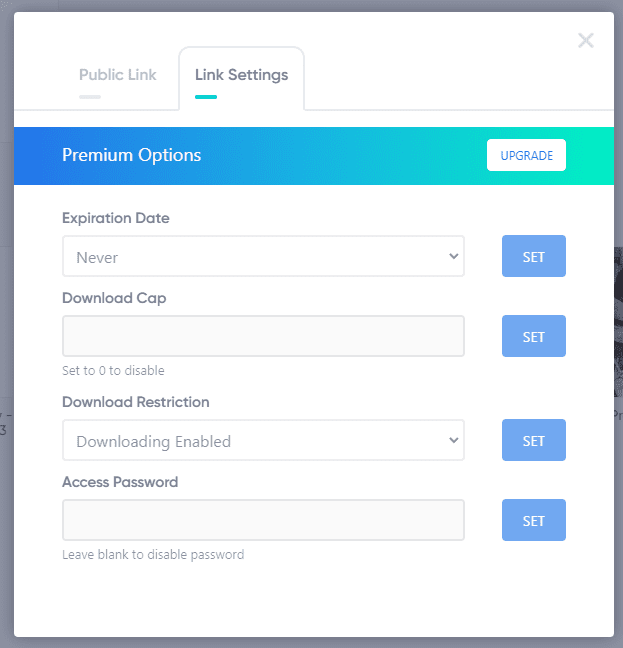
and links is reserved for those on Icedrive’s paid plans.
Creating a link with Icedrive is the more flexible option and comes with additional security settings, like adding password protection. However, these features are only available to those on Icedrive’s paid plans.
Tresorit handles sharing similarly. However, the type of folder you have determines how you can share, which is one of the differences between the two services. Tresorit has classic and next-gen folders, which we will cover below in the section on folder structures.
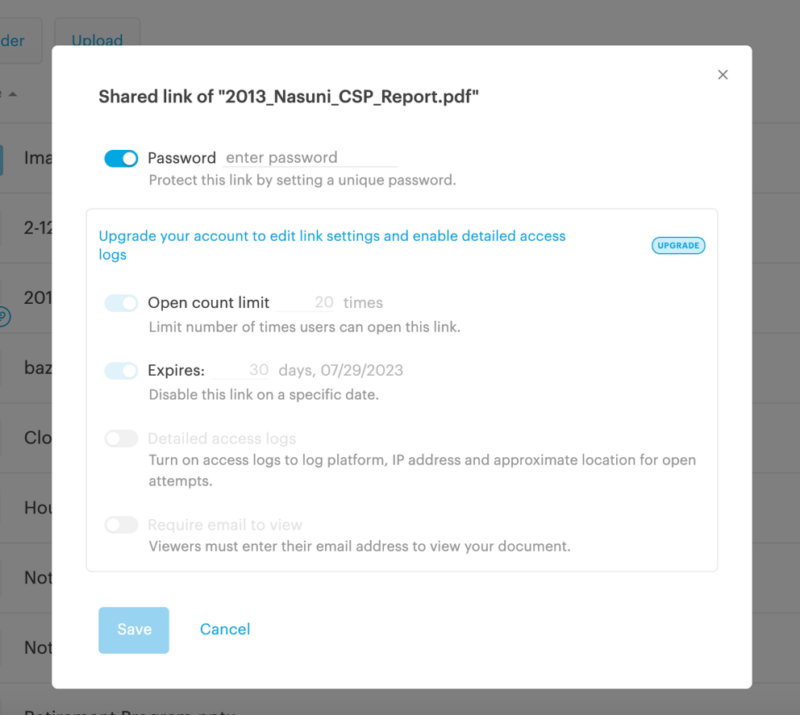
but reserves other security options to paid plans.
For folder sharing, you can create a link to share with others using either folder type. Sharing directly using an email address requires that the recipient also have a Tresorit account. Another option for folder sharing with other Tresorit members is sending a direct link to a folder.
Virtual Desktop Drive
Icedrive and Tresorit have downloadable desktop applications that function like a virtual drive. For Icedrive, the virtual drive is limited to Windows computers. Tresorit’s virtual drive works with both Windows and Mac.
Icedrive’s Windows virtual drive is an excellent addition to an account. It lets you designate folders for offline access, giving you selective sync functionality. Any data you keep in the cloud won’t occupy space on your hard drive, but you’ll still have access to it. Icedrive creates a folder on your desktop with a separate user interface.
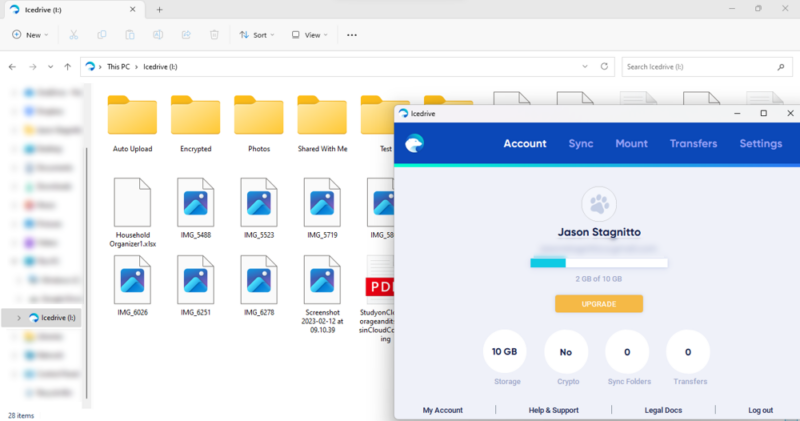
that helps you save hard disk space.
Tresorit’s virtual drive shares many similarities in functionality with Icedrive’s. It creates a folder on your computer that syncs with your cloud account. It also has a user interface that lets you access and work with your data. You can choose to sync or leave folders offline within the app, giving you selective sync functionality.
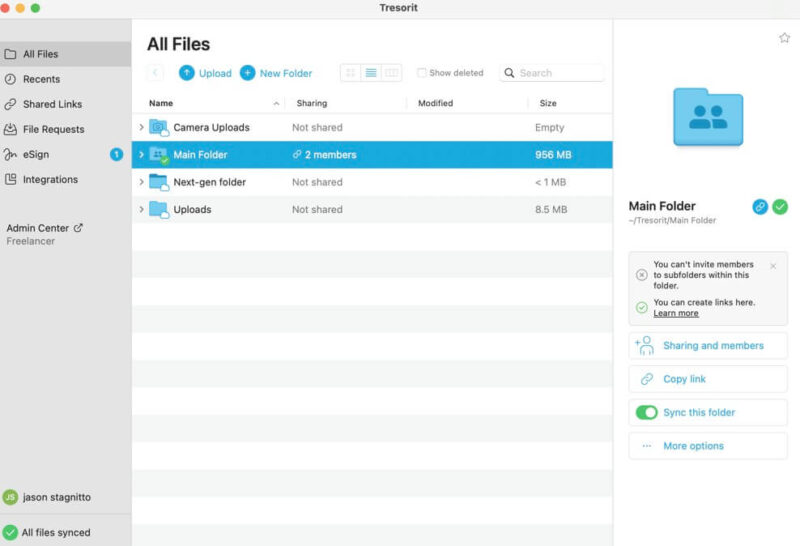
Security
Icedrive and Tresorit are cloud storage services with a focus on security and protecting user data.
Tresorit uses AES 256-bit encryption to protect your data while on its servers, and encrypts your data before it’s shared or transferred using private encryption. The service employs the TLS 1.2 protocol to encrypt the digital hand-off between your account and its servers or when you share folders or files.
Icedrive takes a similarly stringent approach to protection but uses Twofish encryption instead of the AES 256-bit protocol. Both are strong security measures, although Twofish is technically harder to crack — as of this article, Twofish encryption has never suffered a breach. Icedrive protects data transfers using TLS/SSL encryption protocols.
Both services offer account holders additional login protections, like two-factor authentication. Two-factor authentication protects your account if your login credentials become compromised by adding an extra step to the login process.
Privacy
Much like security, privacy is a strong focus for Icedrive and Tresorit. As stated in Icedrive’s privacy policy, it collects only what it needs to process elements of your account, such as payment or logins. It does not share your data with third-party vendors, or sell or share your data for marketing purposes.
Tresorit’s privacy policy goes into greater detail than Icedrive’s and clearly explains what data it collects and how that data is used. For quick skimmers not interested in reading the entire privacy policy, Tresorit provides brief, clear summaries of each section.
Icedrive and Tresorit are EU-based companies that strictly comply with the General Data Protection Regulation (GDPR). Additionally, Tresorit calls Switzerland home; Switzerland has some of the best privacy laws in the world.
Speed
Having fast upload and download speeds may not matter to some. However, speed is certainly a factor for those that work with large files. Both Tresorit and Icedrive are very fast, which is remarkable because cloud storage speed is typically a tradeoff for stringent security and privacy.
Icedrive tops our list of the fastest cloud storage services, with average upload and download speeds of just over seven minutes (for a 5GB data file). We test speeds in a consistent environment using the same combination of different file types adding up to 5GB in total. Our virtual data center has speeds of 1 Gbps, which we cap to 100 Mbps to mitigate potential internet speed variances.
Using the same data and test parameters, Tresorit performed exceptionally well. While not quite as fast as Icedrive, Trestorit averaged around eight minutes for uploads and downloads, using the above test data and conditions. Both services will meet your speed and productivity needs, and you shouldn’t have to wait on data transfers.
Differences
One of the most obvious differences between Icedrive and Tresorit is pricing. Encryption is another key area these services differ. Let’s explore these, among others, below.
Pricing
In terms of pricing, these providers couldn’t be more different.
Icedrive has three plan options. The Icedrive Lite plan provides 100GB of cloud storage for $4.99 per month (one-month plan). The Pro I plan has 1TB of storage space and costs $7.99 per month (one-month plan).
Icedrive’s Pro III plan comes with 3TB of storage space at $10.99 per month (one-year plan) or $8.99 per month (two-year plan). Check out the Icedrive pricing guide for more information.
- Bandwidth limit: 50GB
- 10GB
- Bandwidth limit: 250GB
- 100GB
- Bandwidth limit: 2TB
- 1TB
What Icedrive’s paid plans lack in choice, they make up for in affordability. In comparison, Tresorit offers two plans that are both on the expensive side.
Tresorit’s Personal plan comes with 1TB of storage at $143.88 annually or $13.99 per month. That’s nearly three times the price of Icedrive’s equivalent plan. The Professional plan increases storage space to 4TB and will cost you $329.88 annually or $33.99 billed monthly.
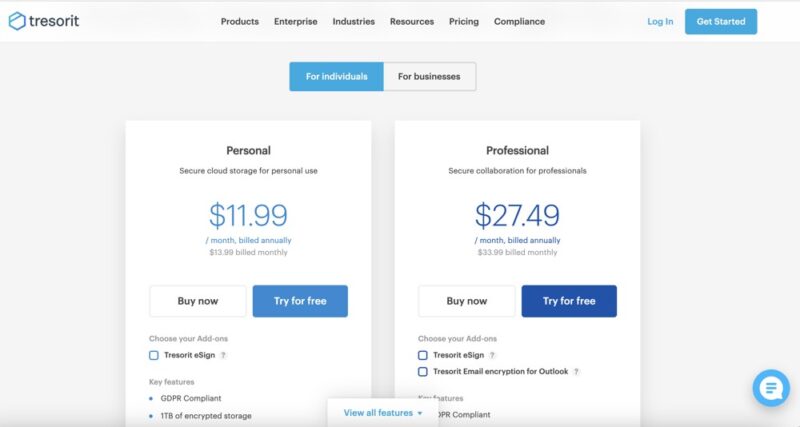
with the paid add-ons. It also has several business plans.
Tresorit is not cheap, and the prices in the above paragraph do not include optional paid add-ons like eSign or encryption for Outlook. Opting for Tresorit eSign adds $6 monthly to the Personal plan or $18 for the Professional. The encrypted Outlook add-on is only available for the Professional plan and increases the total plan cost to $401.88 annually or $41.49 billed monthly.
- 3GB
- 4TB
Beyond individual accounts, Icedrive has lifetime cloud storage options. Icedrive’s lifetime plans are worth considering if you want a cheap cloud storage option and plan to stick with the service for several years — after a certain amount of time, the storage essentially becomes free. Not many other cloud storage services offer lifetime deals, though pCloud is one of them (read Icedrive vs pCloud comparison).
Business Plans
However, Icedrive does not have plan options for businesses with multiple team members. Meanwhile, Tresorit does support businesses, but like its solo plans, the price quickly adds up.
The entry-level Business Standard plan has 1TB of storage, per user, with a minimum of three users. The cost is $14.50 per user per month, with the annual cost being $174 per user. This price is before any add-ons. Tresorit’s Business Plus increases the storage and cost, while its Custom plan is tailored to your business requirements.
Free Accounts
A free account with either Icedrive or Tresorit comes with different benefits and storage amounts. Icedrive makes it easy to sign up for a free account, as it is one of the first elements you’ll see on the home page. A free Icedrive account comes with 10GB of storage space and access to nearly all features.
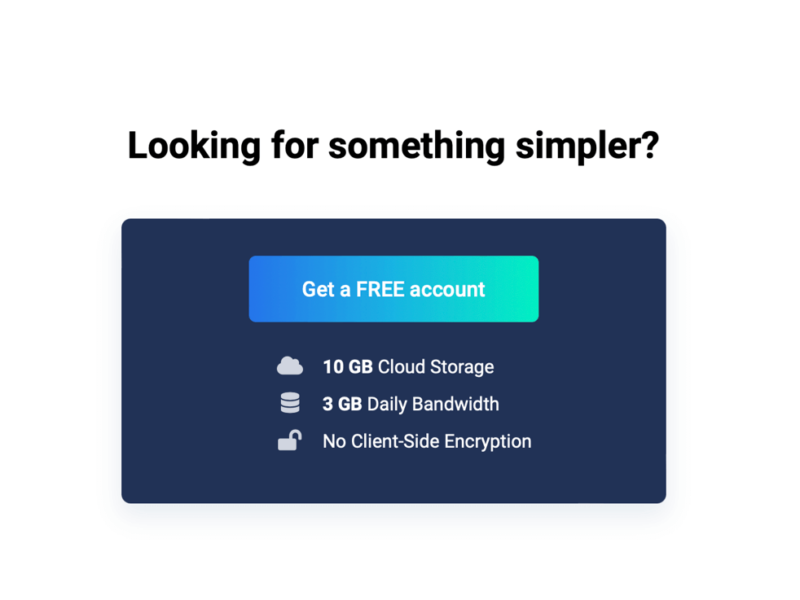
Tresorit also has a free plan, although it’s not entirely apparent from its home page. You will see an option to try its business plans for 14 days, which is an excellent option if you’re looking to sample some of the best business cloud storage.
However, Tresorit does have a free solo account; it’s just hard to find. From the menu along the top, hover over “products” and select “Tresorit Basic.” Fill out the form to get access to 3GB of free cloud storage space. Further down the page, there’s also an option to try its two paid solo plans free for 14 days.
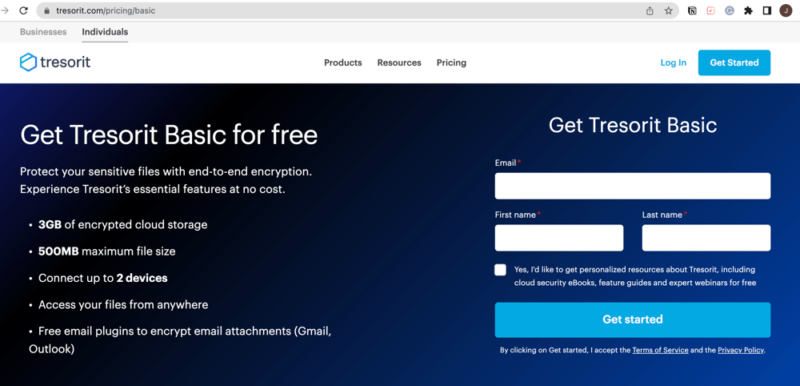
the Tresorit Basic plan gives you 3GB of free storage.
If you’re after a provider with a generous free storage solution, we recommend checking out MEGA. We have comparison articles that look at MEGA vs Icedrive, as well as MEGA vs Tresorit.
Encryption
Icedrive and Tresorit both provide end-to-end, client-side encryption. However, Icedrive limits its encrypted storage option to a folder, while Tresorit applies this level of encryption to your entire account.
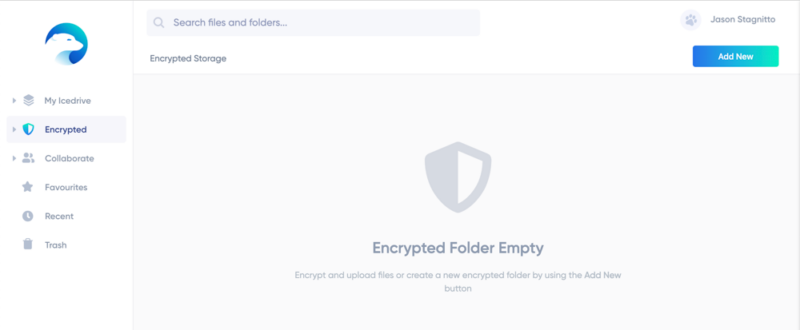
Icedrive’s private encryption folder is only available to paying users, even though you will see this folder on a free account. Anything you store in the encryption folder enjoys zero-knowledge encryption, which ensures that only you have access to its contents. No one else, not even Icedrive, can open your encryption folder or see all your data inside.
Tresorit applies zero-knowledge encryption to your entire account, not just a single folder. As Tresorit does not have access to the encryption keys, it can’t gain access to your account, meaning you maintain control of all your stored data.
Folder Structure
Icedrive uses a standard folder and file structure that resembles what you might see on a desktop. You can upload folders or files directly or use the drag-and-drop method to add them to your account. You can access nested subfolders using a dropdown arrow from the left sidebar. It’s a straightforward structure that should be familiar to almost anyone who’s used a computer.
Tresorit has two different folder structures: classic or next-gen. The difference between the two comes down to what you can share and how. Tresorit’s classic folders limit sharing only to the main or root folders, not subfolders.
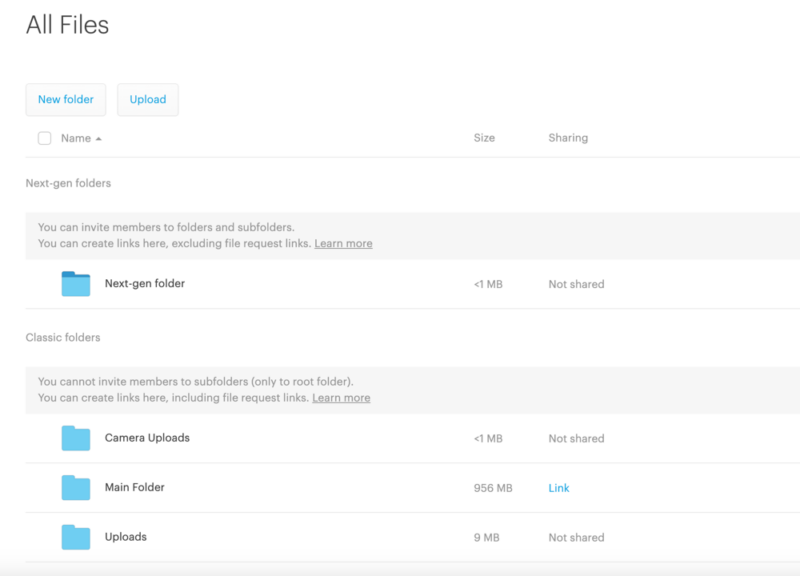
The Tresorit next-gen folders have an almost opposite structure. With a next-gen folder, you can invite collaborators directly to subfolders, making it easier to manage access, especially with people from outside organizations. However, with a next-gen folder, you can’t create file requests.
User Experience
From only a visual perspective, it’s easy to conclude that Icedrive and Tresorit offer very different cloud storage experiences. Icedrive has a modern and sleek interface and provides a more icon-centric navigation system. The website has an uncluttered look that doesn’t get in your way while using it.
By comparison, Tresorit is almost an austere experience with a more dated look. Tresorit relies on drop-down menus for accessing different elements like sharing or viewing file versions. Additionally, the page has a lot of wasted space, particularly with the left sidebar.
User experience is subjective, and the “negatives” highlighted with either option could be positives for certain users. However, if you have to spend a lot of time interacting with your cloud storage service daily, we’d recommend Icedrive.
Integrations
Icedrive and Tresorit do not have many third-party integrations, and from a collaborative perspective, there are probably better options — covered below. With Icedrive, you won’t find any external connections, as it is a self-contained cloud storage solution. What you see is what you get.
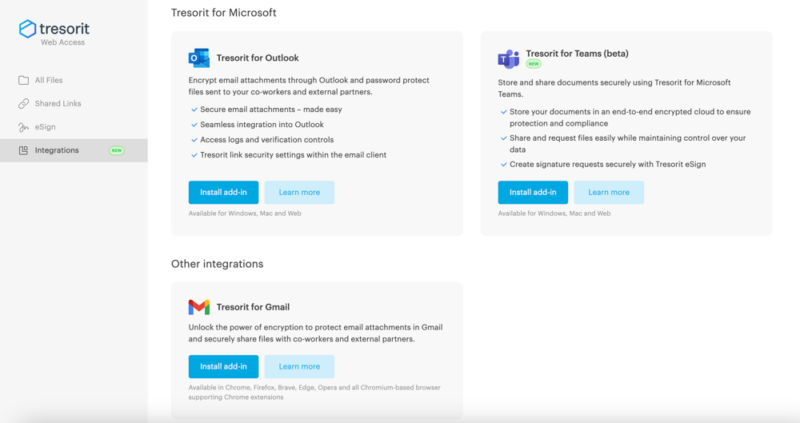
As for collaboration features, Tresorit doesn’t break any barriers with third-party connections. However, it does integrate with Gmail and Outlook. Tresorit will encrypt your email attachments for Outlook and Gmail for free and offers a paid add-on for Outlook that will encrypt your entire email.
Neither service connects to, or supports third-party integrations with, services like MS Office, Google Workspace or productivity apps such as Slack and Zoom.
Which Is Better: Icedrive vs Tresorit?
Tresorit’s entire-account encryption gives it the edge over Icedrive. It also has more flexibility with its plans by offering businesses a way to support teams and projects. However, Tresorit is expensive, and there are other more accessibly priced services for individuals and businesses.
Icedrive is the more affordable option and offers lifetime plans for those who like sticking with a service for a while. However, Icedrive has no external integrations and could be better for helping keep its users productive. Tresorit is similarly limited, but it at least integrates with Outlook and Gmail.
We Recommend Icedrive If You Want…
- An excellent user experience: Icedrive’s interface has a modern look and feel, making it easy to use for long periods of time.
- Lifetime plans: If you plan on staying with Icedrive for a while, purchasing a lifetime plan is a smart investment that will eventually pay for itself.
- Free cloud storage: Icedrive’s free account comes with 10GB of storage, which is plenty to get a good feel to test its features.
We Recommend Tresorit If You Want…
- End-to-end encryption: Every Tresorit account comes with private encryption, which protects your data from unauthorized access.
- Business plans: Businesses have several choices to support teams and projects, including an enterprise option for custom requirements.
- External integrations: Tresorit integrates with Outlook and Gmail. Attachments are encrypted, and the service offers a paid add-on to encrypt entire Outlook emails.
If You Want to Consider Other Services, Check Out…
- 1
- :
- :
- :
- :
- 2
- :
- :
- :
- :
- 3
- :
- :
- :
- :
- 4
- :
- :
- :
- :
- 5
- :
- :
- :
- :
Sync.com takes a similar approach to Tresorit by applying zero-knowledge encryption to an entire account, meaning only you can access your data. It has a free plan with 5GB of cloud storage, making it easy to try out the service. We take a look at all the details in our Sync.com review or our Icedrive vs Sync.com guide.
MEGA is another cloud storage service that prioritizes user protection and privacy. It also protects an entire account with private encryption, including free accounts. With MEGA’s free account, you’ll get 20GB of storage. If you want to learn more, check out our MEGA review.
Dropbox Business takes the best elements of Dropbox — like file sharing and syncing — and adds features to support team collaboration and productivity. It supports many popular third-party connections, such as MS Office and Google Workspace, and also comes with Dropbox native apps like Dropbox Paper. We cover more in our Dropbox Business review or in our Dropbox vs Tresorit comparision.
Box is another solid option for businesses, as it has a robust admin panel giving managers plenty of flexibility to customize team experiences. Sadly, most of the best features of the admin console are locked behind the more expensive paid plans. Overall, Box does an excellent job supporting business, as we cover in our Box review.
The Verdict: Why We Think Tresorit Wins Overall
With its combination of end-to-end encryption for an entire account and email integrations that protect attachments, we give Tresorit the nod over Icedrive. However, to get the most out of Tresorit, you’ll need to pay, and the Tresorit plans and add-ons are anything but affordable. If you only need secure and private cloud storage at a decent price, Icedrive is a worthy choice.
Are you a Tresorit or Icedrive user? Which do you consider the better cloud storage service? What key features are you looking for in cloud services? Is it important to you that data stored can be secured with encrypted files or do you want all your files protected? Do you use another cloud storage service? Let us know in the comments section below. Thanks for stopping by to read our article.
FAQ: Tresorite vs Icedrive Compared
Yes, Icedrive takes customer privacy and protection seriously, with a privacy policy that’s easy to understand and clear on how it collects and uses your data.
Tresorit’s best value comes from subscribing to one of its paid plans. It can become expensive, but if it meets your needs, Tresorit is worth the cost, especially for its excellent encryption.
Icedrive does a better job of minimizing the data it collects on its account holders, and it offers a zero-knowledge encryption folder for its paying members. However, for productivity and collaboration, Google Drive is the clear choice.




